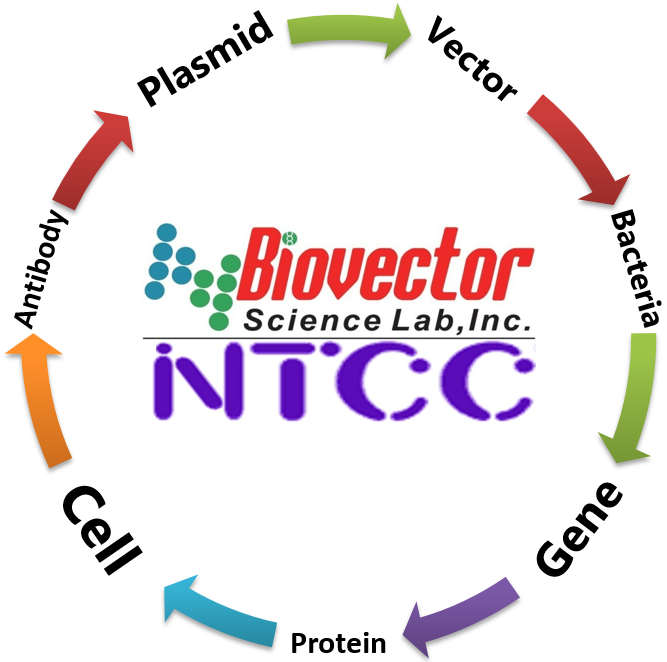pMTL007C-E2梭菌基因敲除载体ClosTron系统质粒-BioVector Inc.
- 价 格:¥99850
- 货 号:BioVector-pMTL007C-E2
- 产 地:北京
- BioVector NTCC典型培养物保藏中心
- 联系人:Dr.Xu, Biovector NTCC Inc.
电话:400-800-2947 工作QQ:1843439339 (微信同号)
邮件:Biovector@163.com
手机:18901268599
地址:北京
- 已注册
The BioVector pMTL007C-E2 plasmid is a key component of the ClosTron system, a highly efficient and widely used gene knockout system primarily developed for genetic manipulation in the Clostridium genus.
Here's a breakdown of its features and applications:
Key Features:
Second-generation ClosTron plasmid: It's an improved version of the initial pMTL007 plasmid.
Gene Knockout/Disruption: Its primary function is to facilitate the precise inactivation of target genes in bacteria, especially Clostridium species. This is achieved through the insertion of a modified Group II intron.
Group II Intron: The plasmid contains a Group II intron encoding region (specifically, the Ll.ltrB intron) into which an erythromycin resistance gene (ermB) is inserted. This ermB gene is a "retrotransposition-activated marker" (RAM), meaning it confers erythromycin resistance only upon successful integration into the host chromosome.
Constitutive Promoter: Unlike earlier versions that required IPTG induction, pMTL007C-E2 utilizes a constitutive fdx promoter from Clostridium sporogenes to direct the expression of the Group II intron, making the system more straightforward and efficient.
Thiamphenicol Resistance (catP marker): It carries the catP gene, which confers resistance to thiamphenicol, allowing for selection and maintenance of the plasmid in host cells.
Clostridium-E. coli Shuttle Vector: The plasmid is designed to replicate in both Clostridium and E. coli, facilitating cloning and manipulation in E. coli before transfer to Clostridium.
Modular Design (pMTL8000 series format): It conforms to the pMTL8000 modular plasmid series, allowing for easy substitution and re-assembly of different plasmid components (e.g., antibiotic resistance markers, replicons, application-specific modules).
How it works (ClosTron System):
Retargeting: The specificity of the Group II intron for a particular target gene is modified by designing specific "retargeting" primers. These primers, based on the target gene's sequence, alter the intron RNA.
Cloning: The retargeted intron is cloned into the pMTL007C-E2 plasmid.
Transformation/Conjugation: The modified plasmid is introduced into the Clostridium host (often via conjugation from an E. coli donor strain).
Retrohoming: Once inside the Clostridium cell, the expressed Group II intron, along with its associated reverse transcriptase, recognizes and inserts itself into the specifically targeted site within the host chromosome.
Gene Inactivation and Selection: The insertion of the intron into the target gene disrupts its function, leading to a gene knockout. The insertion also brings the ermB gene (originally inactivated in the plasmid) into an active orientation, conferring erythromycin resistance to the host cell. This allows for easy selection of successful gene knockout mutants.
Plasmid Loss: After the intron insertion, the plasmid is typically lost from the cell, preventing further intron mobility and ensuring the stability of the chromosomal mutation.
Applications:
The pMTL007C-E2 plasmid, as part of the ClosTron system, has revolutionized genetic engineering in Clostridium species and has numerous applications, including:
Gene Knockout Studies: It is widely used to inactivate specific genes to understand their function in various Clostridium species (e.g., C. difficile, C. acetobutylicum, C. botulinum, C. sporogenes, C. pasteurianum).
Metabolic Engineering: By disrupting genes involved in metabolic pathways, researchers can redirect metabolic flux to enhance the production of biofuels (e.g., butanol, ethanol) or other valuable chemicals.
Studying Virulence Factors: In pathogenic Clostridium species, it helps in identifying and characterizing genes essential for pathogenicity, sporulation, and toxin production.
Essential Gene Identification: The system can be adapted to identify essential genes in Clostridium, which are potential targets for new antimicrobial drugs.
Creation of Stable Mutants: The resulting mutants, with the intron integrated into the chromosome, are highly stable compared to those created by single-crossover plasmid integration.
Cargo DNA Delivery: Beyond simple gene disruption, the ClosTron system can also be used to deliver other DNA sequences (cargo DNA) to specific sites in the genome.

BioVector NTCC Inc.
www.BioVector.net
您正在向 biovector.net 发送关于产品 pMTL007C-E2梭菌基因敲除载体ClosTron系统质粒-BioVector Inc. 的询问
- 公告/新闻




